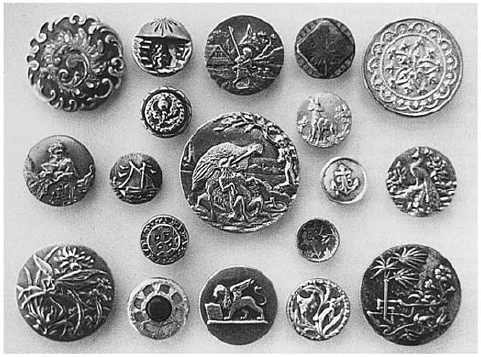Buttons (3 page)
The fashion for fitted clothing for women returned in the mid nineteenth century, and buttons became part of the style. The cheaper sew-through buttons of china, pearl, glass, bone or linen were used in abundance on the profuse underwear, but the lady would choose beautifully made, decorative buttons for her dresses and jackets. Best dresses were not frequently washed and the buttons were not washable. To save sewing and resewing, clips or split rings were used to enable easy removal. As quality buttons were a treasured item, they were seen as a most acceptable gift. In addition to the products of the English market, other exotic buttons were imported from around the world or brought back as souvenirs from the Grand Tour. By the end of the century it had become a custom for a lady to have amongst her twenty-first birthday presents a set of six silver buttons presented in a velvet-lined, leather box. In the nineteenth century, as in the twentieth, decorative buttons for gentlemen were generally confined to waistcoats or dress shirts. Covered or plain sew-through buttons of horn, nut or, later, composition were used on their outer jackets or coats. The strict adherence to what was considered correct was important in Victorian Britain.
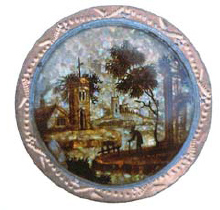
Eighteenth-century dandy button, reverse-painting on glass over pearl chips on copper.
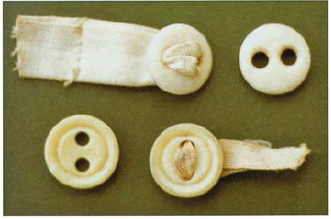
Ladies’ underwear buttons. Note the disproportionately large holes needed to accommodate the tape which provided extra flexibility when adjusting the garments.
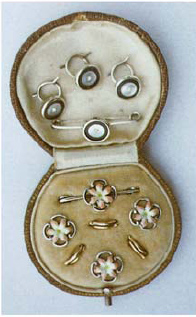
Boxed set, including a matching brooch, of silver and enamel buttons, hallmarked Birmingham 1911. A further set of similar dates is arranged in the lid. Both sets include split rings.
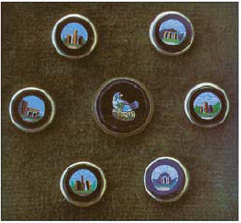
Selection of micro-mosaics. The outer six depict Roman ruins, evoking memories of the Grand Tour.

(Corners) Carved lava, probably Italian, showing classical heads, mounted in silver. (Centre four) Miniatures depicting tiger-hunting in India, glass-covered and mounted in silver.
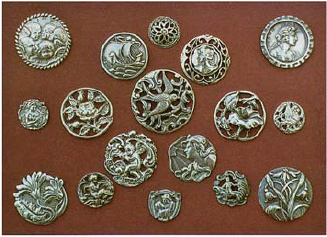
Hallmarked silver buttons, c. 1900, of the type frequently boxed as gift sets of six.

Nine gentlemen’s waistcoat buttons and four dress shirt buttons.
After the death of Prince Albert in 1861, Queen Victoria was rarely seen in anything other than black, setting a precedent for all. Black buttons were made in profusion, mostly of glass but also from pressed, dyed horn, vegetable ivory and papier mâché.
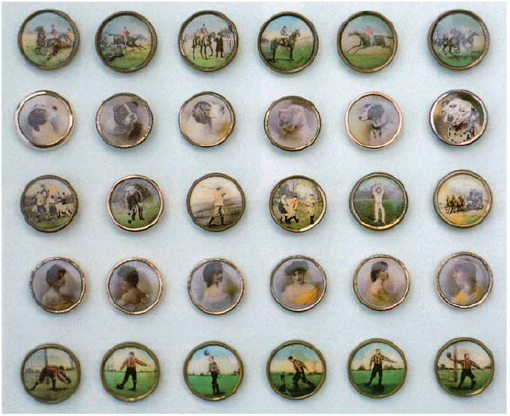
Gentlemen’s waistcoat buttons from the late nineteenth and early twentieth centuries.
Towards the end of the nineteenth century there was a revolt against the rigidity of Victorian costume, tentatively beginning with the Aesthetic movement of the 1880s and culminating in the total upheaval brought about by the First World War. Women wished to have careers and follow more active leisure pursuits, necessitating versatile, washable clothes. A somewhat mannish style in women’s clothing followed and, coupled with the demise of the lady’s maid, front-fastening garments became more fashionable. Birmingham was no longer the centre of the world’s button trade: it became desirable for the lady to have some part of her clothing from Paris. The medieval-inspired Arts and Crafts movement, which gave rise to the Art Nouveau style, was reflected in the design of buttons. There was also a vogue for picture buttons. People, theatre scenes and book illustrations were all used. They were probably easily recognised in their day but now some research is needed to identify them. Technical advances meant that the look of many precious materials could be expertly reproduced in glass, celluloid and its derivatives, bringing fancy novelty buttons to the lower-priced ranges.
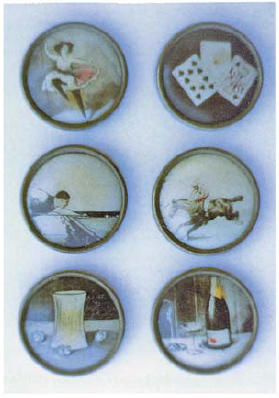
Gentlemen’s waistcoat buttons from the late nineteenth century and the early twentieth century. This set was sold on cards with such legends as ‘The Road to Ruin’ or ‘The Downfall of Man’. It is interesting to note that, at a time when true gentlemen played only billiards, snooker was considered to be a shameful pastime.
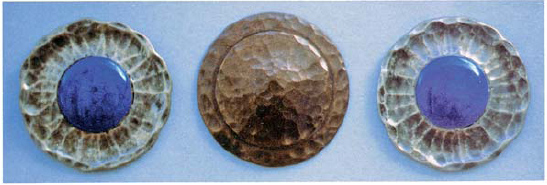
Metal buttons typical of the Arts and Crafts style. The centre button is copper and the outer two are pewter set with a ceramic disc.
